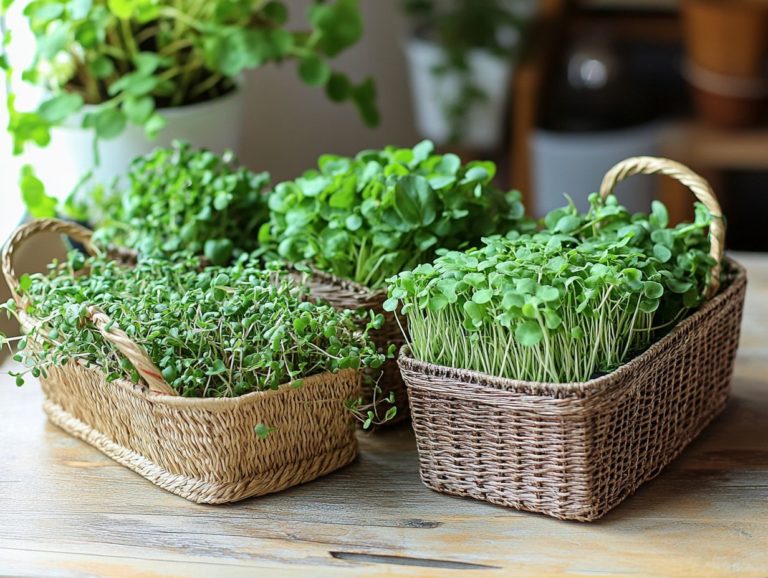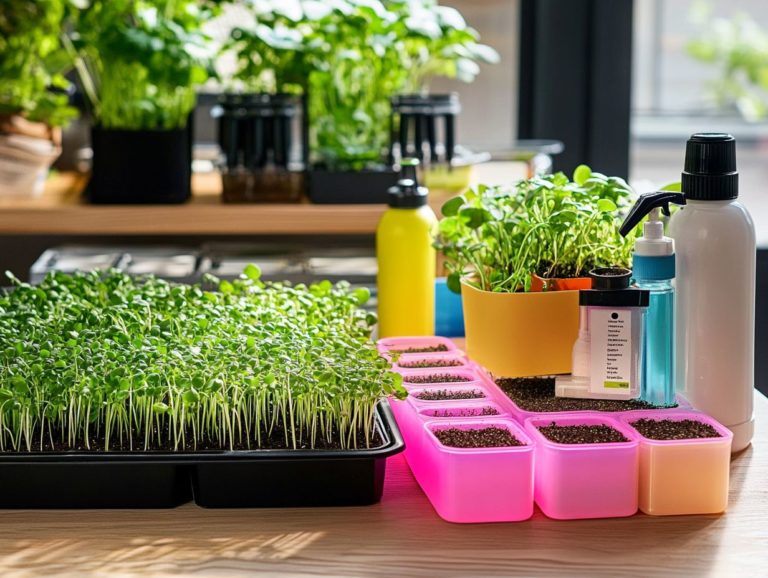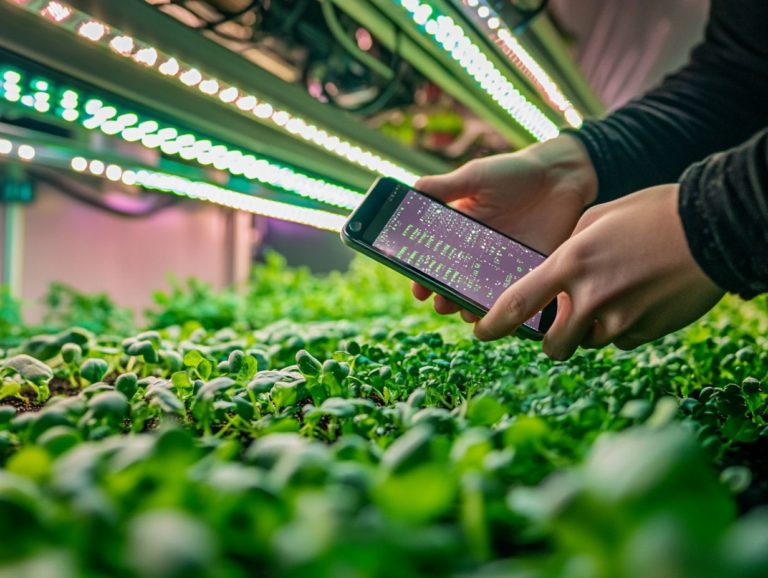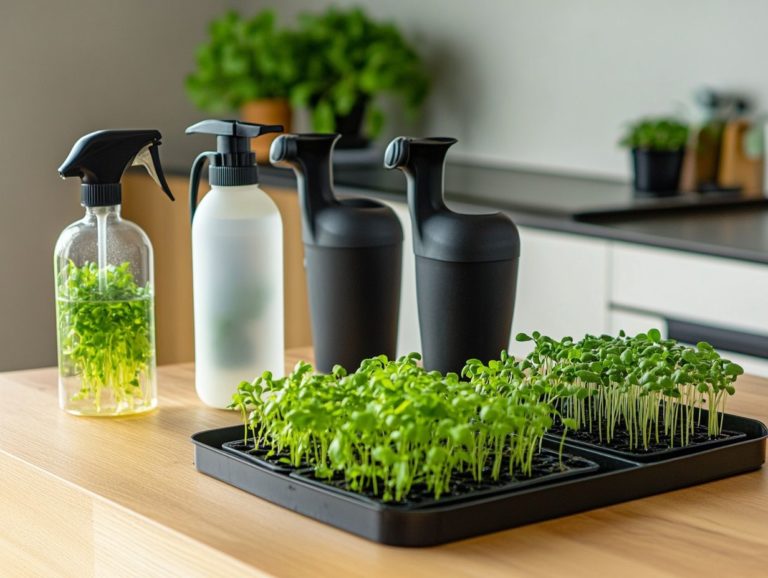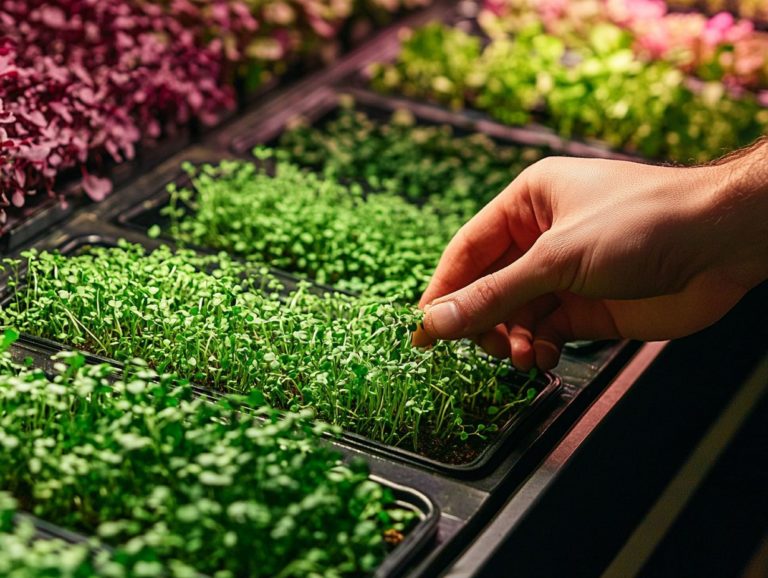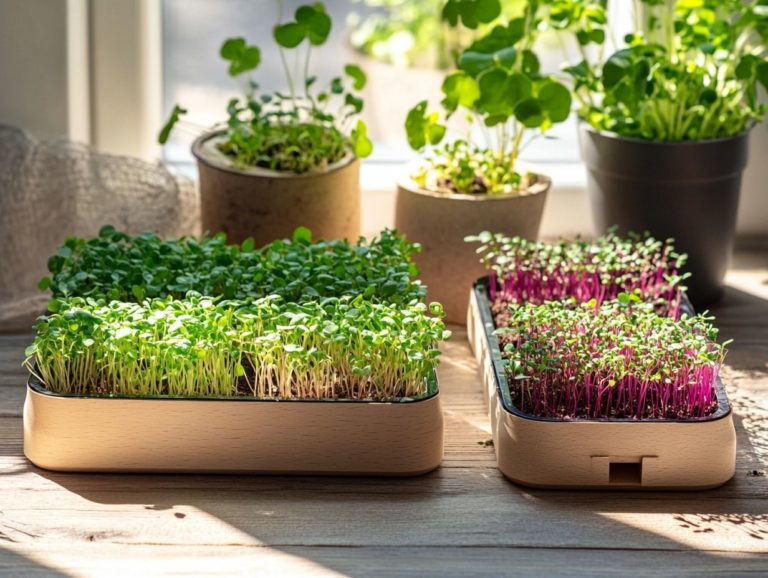Best pH Meters for Microgreen Hydration
Understanding the optimal pH levels is vital for cultivating healthy microgreens. This makes pH meters indispensable tools for any dedicated grower.
This article delves into the importance of pH meters in the hydration of microgreens and provides valuable insights on selecting the ideal meter for your specific needs.
You’ll discover essential features, thoughtful recommendations, and practical tips for both usage and maintenance. This will equip you with everything necessary to nurture a thriving microgreen garden.
Ready to transform your microgreens into a delicious garden? Let s dive in!
Contents
- Key Takeaways:
- 2. Why Are pH Meters Important for Microgreen Hydration?
- 3. Factors to Consider When Choosing a pH Meter for Microgreens
- 4. Top 5 pH Meters for Microgreen Hydration
- How Do These pH Meters Work?
- What Are the Key Features to Look for in a pH Meter for Microgreens?
- What Are the Pros and Cons of Each pH Meter?
- How Accurate Are These pH Meters?
- What Are the Customer Reviews for Each pH Meter?
- Which pH Meter Is Best Suited for Different Budgets?
- How Can a pH Meter Help with Microgreen Growth and Health?
- What Are Some Common Mistakes to Avoid When Using a pH Meter for Microgreens?
- Are There Any Additional Features or Accessories That Come with These pH Meters?
- How Easy Are These pH Meters to Use and Maintain?
- What Are Some Tips for Properly Calibrating and Storing pH Meters?
- What Are the Long-Term Benefits of Using a pH Meter for Microgreens?
- Frequently Asked Questions
- What are the best pH meters for microgreen hydration and pH testing?
- How do I know which pH meter is best for my microgreen hydration needs?
- Can I use a regular pH meter for my microgreen hydration process?
- Are there any budget options for pH meters for microgreen hydration?
- Do I need to calibrate my pH meter for microgreen hydration?
- Can I use a pH test strip instead of a pH meter for microgreen hydration?
Key Takeaways:
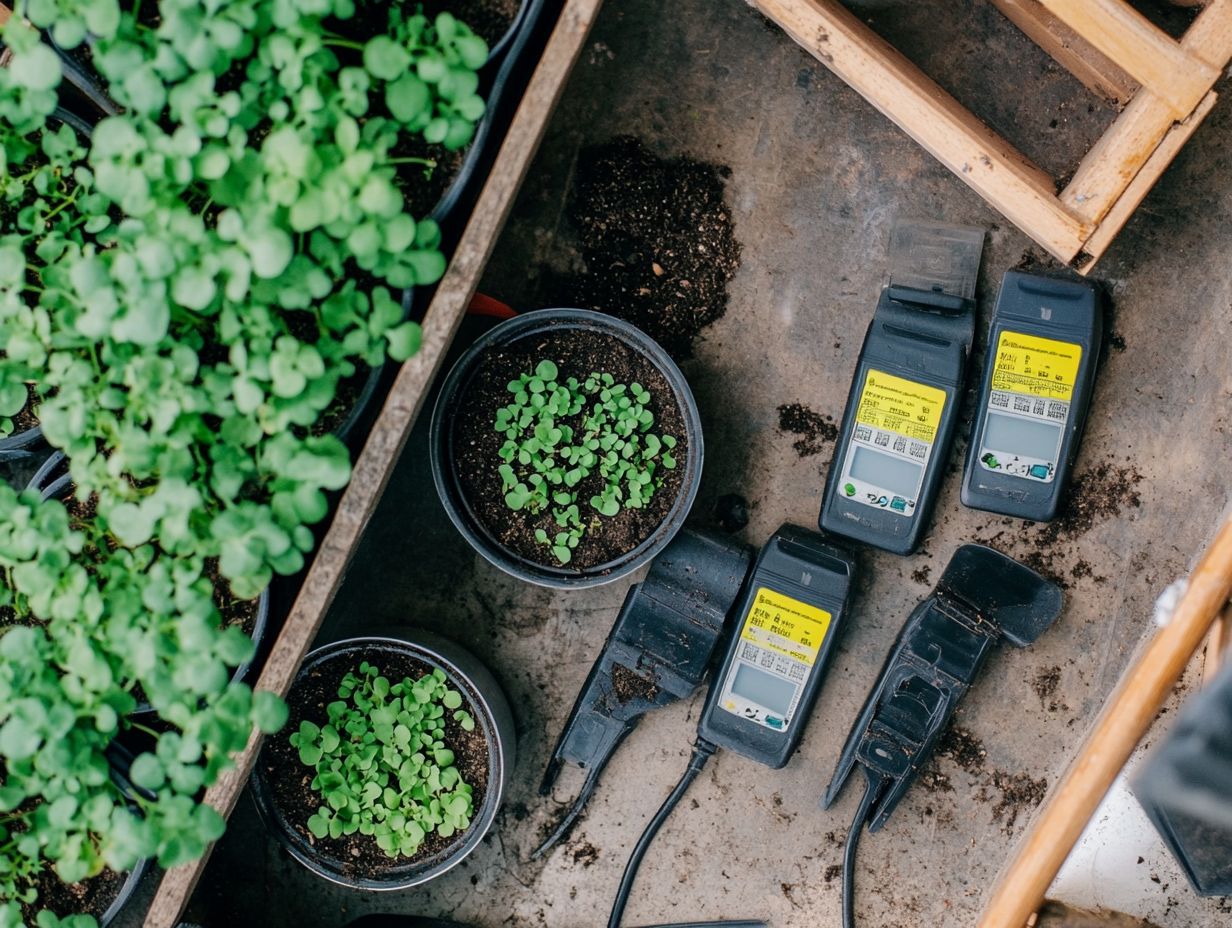
- Monitor pH levels regularly for healthy microgreens.
- Choose a pH meter based on accuracy and reviews.
- Calibrate your meter regularly for better long-term growth.
2. Why Are pH Meters Important for Microgreen Hydration?
pH meters are essential for ensuring your microgreens stay properly hydrated. They accurately measure the pH levels of the nutrient solution, which impacts water quality and nutrient absorption.
By monitoring these levels, you can create an ideal acidic environment that fosters healthy plant growth and maximizes yield. This precision in pH measurement is crucial for the overall success of your hydroponic system, which means growing plants without soil, using water mixed with nutrients.
Understanding pH levels is vital for optimal hydration and nutrient absorption. Even minor fluctuations can diminish a microgreen’s ability to draw on available nutrients effectively.
A balanced pH encourages roots to absorb essential minerals, enabling your plants to thrive and develop rich flavors and textures. With pH meters at your disposal, you can quickly identify any imbalances and make necessary adjustments.
This results in healthier crops that are more resilient to pests and diseases. Consistent monitoring simplifies your growing process and enhances sustainability, allowing for successful harvests without excessive fertilizers or chemicals.
3. Factors to Consider When Choosing a pH Meter for Microgreens
Selecting the right pH meter requires careful consideration of key factors such as accuracy, ease of calibration, portability, and budget options. Each element significantly influences the effectiveness of your gardening efforts.
A quality pH meter should provide reliable measurements while being user-friendly and easy to maintain.
Features like calibration reminders and long-lasting probes can enhance usability when monitoring pH levels. When considering accuracy, remember it affects not just immediate readings but also the long-term health of your plants.
Microgreens thrive in specific pH ranges, making calibration features crucial for precise readings over time. Choose a model that fits within your budget. This ensures you acquire quality equipment without straining finances, striking a balance between cost and reliability. Additionally, consider learning how to choose the best hydration methods for microgreens, ultimately leading to better gardening outcomes.
4. Top 5 pH Meters for Microgreen Hydration
Selecting the right pH meter for microgreen hydration is crucial for gardening success. Here are five top options available to you!
Each pH meter from renowned brands like Apera Instruments, Bluelab, and Hanna Instruments offers unique features tailored to your specific needs. Whether you seek budget-friendly choices or advanced digital capabilities, these meters deliver accurate readings with ease. They re perfect for both novice and seasoned hydroponic gardeners.
These meters not only ensure precision; they also feature intuitive interfaces, making them accessible for anyone eager to optimize their plants’ growth. From straightforward handheld models for hobbyists to sophisticated devices that connect to apps for real-time monitoring, each meter has something special to offer!
Features like automatic temperature compensation and the ability to store multiple readings enhance usability. With price ranges suitable for casual gardeners and dedicated professionals alike, you re bound to find the perfect fit for your budget and expertise level.
How Do These pH Meters Work?
pH meters gauge the voltage difference between specialized probes: a reference electrode and a glass electrode. This difference provides the pH reading displayed on the device.
Caring for your probes and regularly calibrating them with appropriate calibration solutions is essential for accuracy. By understanding the technology behind these devices, you ll be better equipped to maintain your pH meters for optimal performance.
The glass membrane of the probes allows hydrogen ions to pass through, generating a charge measurable by your meter. The reference electrode, typically filled with a stable pH solution, provides a consistent voltage against which the glass electrode’s voltage is compared.
Calibration is vital; it involves adjusting the meter to known pH values to ensure accurate readings over time. Best practices for probe care include:
- Rinsing the probe with distilled water after each use.
- Storing it in a specialized solution to keep the glass from drying out.
Regular maintenance extends the probe s lifespan and guarantees reliable measurements every time!
What Are the Key Features to Look for in a pH Meter for Microgreens?
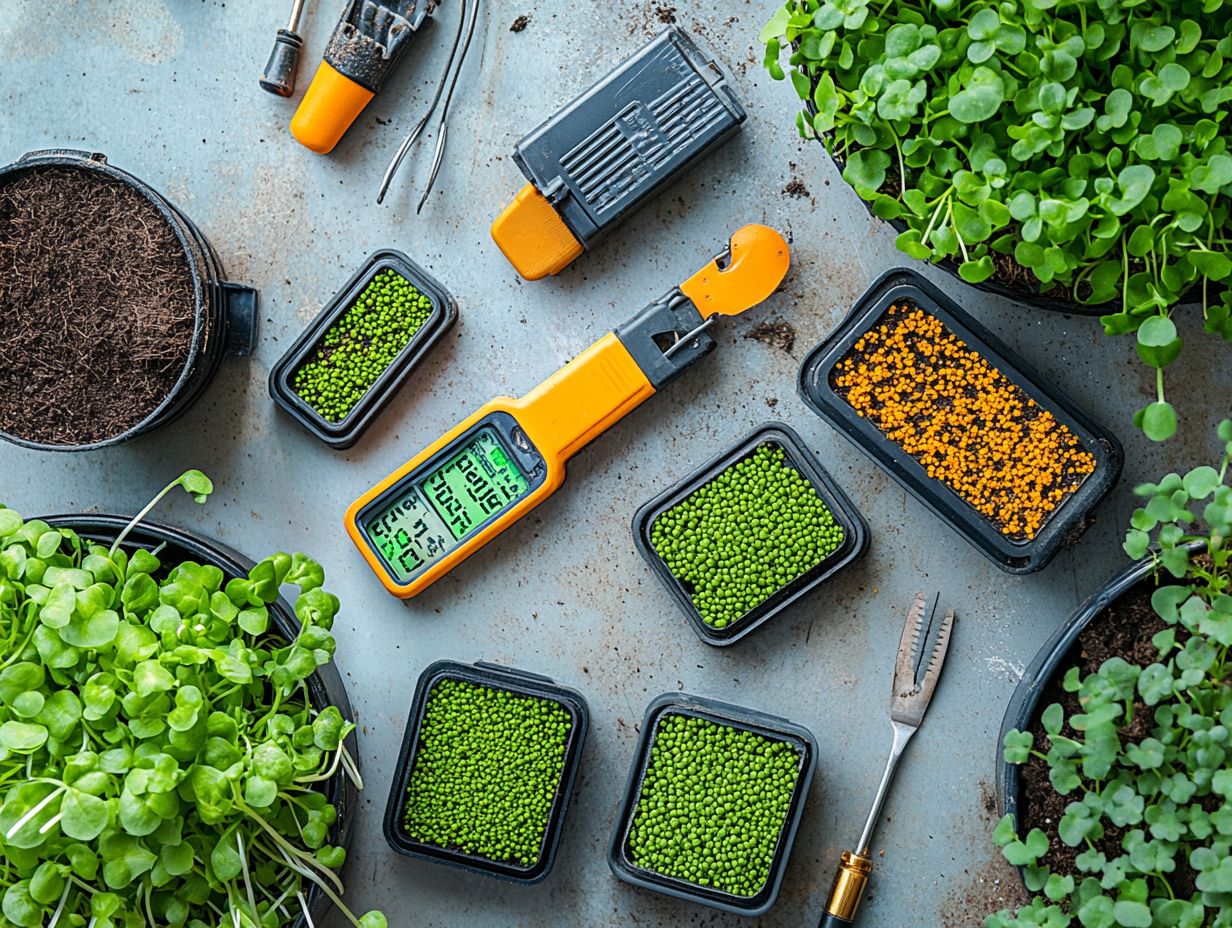
When selecting a pH meter for your microgreens, focus on key features that ensure optimal performance and simplify your gardening experience. Look for user-friendly interfaces, accurate measurement capabilities, and effective calibration options.
Portability is also crucial; you’ll want a compact meter that you can easily move around your hydroponic setup. Opt for pH meters with small probes that are tailored for delicate environments, as they are perfect for monitoring the health of your microgreens. Additionally, understanding the perfect pH level for microgreens will ensure optimal growth.
Many advanced devices come with LCD screens that deliver clear readings and intuitive menus. This allows you to navigate settings effortlessly, even as a novice. A quick response time from the sensors means you can promptly make necessary adjustments, promoting healthier growth and improving yield quality!
Many models also boast waterproof designs, enhancing durability an essential feature when managing fluctuating moisture levels in your growing environments.
By incorporating these user-friendly, portable, and precise tools, you can take charge of your microgreens health today! This proactive approach leads to more robust plant development and a bountiful harvest.
What Are the Pros and Cons of Each pH Meter?
Understanding the pros and cons of various pH meters is crucial for your purchasing decisions. Different models shine in certain aspects while falling short in others.
Some pH meters deliver exceptional reliability and accuracy, while budget-friendly options may skimp on vital features or durability.
By diving into user feedback and evaluating the strengths and weaknesses of each model, you can identify the perfect pH meter tailored to your specific needs.
For example, some high-end pH meters are lauded for their precision and effortless calibration, making them favorites among professionals and dedicated hobbyists. However, these premium options often come with a hefty price tag, which might discourage those on a budget.
On the flip side, more affordable meters may appeal to beginners or occasional users. However, reviews often reveal shortcomings in durability and accuracy over time.
Many users highlight the importance of customer support and warranty offerings, as these can greatly impact satisfaction and the long-term usability of your pH meter.
How Accurate Are These pH Meters?
The accuracy of pH meters can vary widely among different models and brands, making it essential for you to test their accuracy when considering them for hydroponic applications.
A reliable meter should consistently provide readings across a defined pH range. Regular calibration, which involves adjusting your device to ensure it provides accurate readings, with the appropriate solutions is crucial for ensuring precise measurements.
Understanding the specifications and accuracy ratings of various pH meters will empower you to select the best option tailored to your specific needs.
Factors such as temperature fluctuations and the age of the sensor also significantly impact the precision of these devices.
To maintain reliable readings, you should regularly clean the electrodes and store them according to the manufacturer’s instructions; neglecting these steps can lead to drift in your measurements.
Industry standards set by organizations like the International Society for Analytical Chemistry (ISAC) outline acceptable accuracy thresholds, serving as a valuable guideline for assessing your meter’s performance.
By following these calibration and maintenance tips, you can greatly enhance your pH meter’s longevity and accuracy, ensuring optimal conditions for your hydroponic systems.
What Are the Customer Reviews for Each pH Meter?
Customer reviews are a treasure trove of insights into the performance and reliability of various pH meters, empowering you to make informed decisions based on genuine user experiences.
Feedback from growers often highlights crucial aspects such as ease of use, accuracy of readings, and overall durability, enabling you to weigh the pros and cons of each model effectively.
By aggregating comments from users, it becomes evident that many appreciate specific features like quick calibration processes and intuitive displays. However, recurring concerns about battery life and calibration frequency point to areas ripe for improvement.
Such insights not only illuminate the strengths of popular models but also flag potential pitfalls to avoid, guiding you toward options that best meet your unique needs.
These reviews not only reflect customer satisfaction but also serve as your roadmap through the myriad choices available in the realm of pH meters.
Which pH Meter Is Best Suited for Different Budgets?
Finding the best pH meter that fits your budget is crucial if you aim to strike the perfect balance between cost, quality, and reliability in your gardening tools. There are plenty of options available at various price points, catering to both budget-minded gardeners seeking dependable meters and those ready to invest a bit more for enhanced features.
If you’re working within a limited budget, you’ll find basic pH meters that deliver simplicity and reasonable accuracy without straining your wallet. These economical choices are ideal for home gardeners or small-scale hobbyists who need reliable tools without the bells and whistles.
Conversely, if you re a serious grower or involved in commercial operations, premium pH meters offer a range of advanced functionalities, such as wireless connectivity and automatic temperature compensation, improving your gardening skills.
Ultimately, understanding your specific needs like how often you plan to use the meter and the unique conditions of your growing environment will help you make an informed decision that suits your financial situation while ensuring that your plants thrive.
How Can a pH Meter Help with Microgreen Growth and Health?
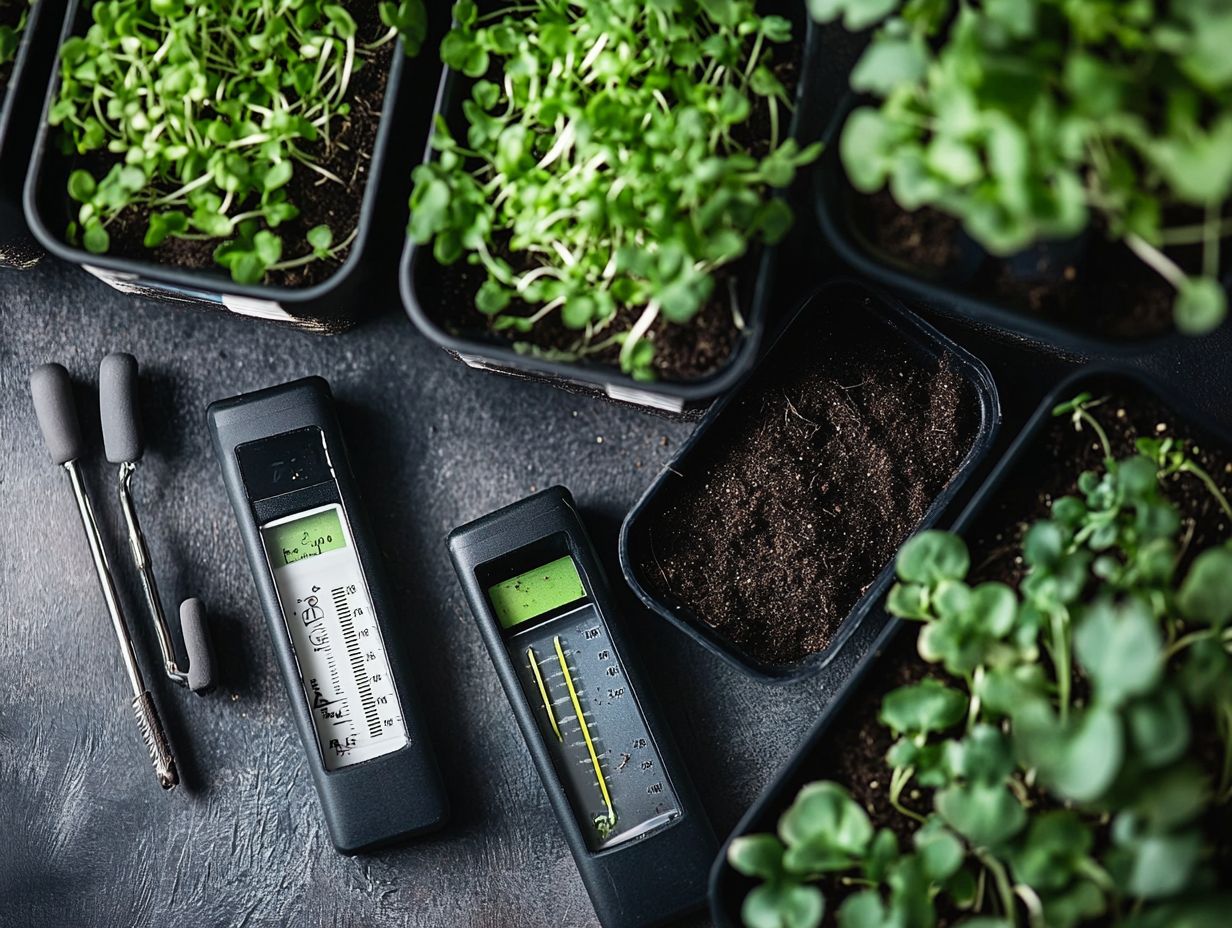
Ready to take your microgreens to the next level? Utilizing a pH meter allows you to monitor and adjust the pH levels of your nutrient solutions, optimizing nutrient availability and water quality. By making these adjustments, you create the ideal conditions that promote robust growth, leading to healthier plants and ultimately greater yields. When you maintain the ideal pH range, you substantially enhance the overall success of your hydroponic systems.
Keeping the right pH balance is crucial. It directly affects how well your plants can absorb nutrients, ensuring that vital elements like nitrogen, phosphorus, and potassium are readily available for absorption. When the pH is off-kilter, even the finest nutrient solutions can turn ineffective, resulting in deficiencies that stunt growth and undermine vitality.
Regular monitoring not only helps you maintain optimal conditions, but it also gives you the power to make timely adjustments, preventing potential issues before they escalate. By prioritizing pH management, you can cultivate microgreens that are not only healthier but also more resilient, maximizing your overall harvest potential and ensuring you get the best yields from your hydroponic solutions. Don’t wait until it’s too late; start monitoring your pH levels today for thriving plants!
What Are Some Common Mistakes to Avoid When Using a pH Meter for Microgreens?
When using a pH meter for your microgreens, several common mistakes can significantly hinder the effectiveness of this essential tool. Neglecting proper probe care and failing to calibrate regularly can lead to inaccurate readings, jeopardizing the health of your microgreens and undermining your hydroponic efforts. By identifying and sidestepping these pitfalls, you can ensure more reliable and accurate pH measurements.
One major oversight is not calibrating the meter according to the manufacturer s instructions. This should be done before each use or at least once a week to maintain optimal accuracy. Many users forget to clean the probe after each measurement, which can lead to contamination and skewed results. Proper storage of the probe is equally important; keeping it in a solution that maintains its humidity when not in use is essential.
Consistent monitoring practices, such as checking the pH levels at the same time each day, can significantly enhance the reliability of the data you collect. By paying attention to these details, you can cultivate healthier microgreens with confidence. Stay vigilant with your pH measurements and watch your microgreens flourish like never before!
Are There Any Additional Features or Accessories That Come with These pH Meters?
Many pH meters come with a suite of additional features and accessories that elevate their functionality and ease of use, streamlining your overall measurement process. These often come with calibration kits that guarantee accurate readings, along with maintenance tools designed to simplify probe care and extend the lifespan of your device.
Calibration solutions include pH buffer solutions, which stabilize the acidity or alkalinity levels, crucial for ensuring your meter delivers accurate results in fluctuating conditions. Maintenance tools like cleaning solutions and storage caps are vital for preserving your probe’s accuracy and longevity. Regular calibration and maintenance can greatly enhance your experience and ensure reliable readings.
Being aware of these accessories gives you the power to maximize the potential of your pH meter, optimizing plant health and yield in your gardening ventures.
How Easy Are These pH Meters to Use and Maintain?
The ease of use and maintenance of pH meters is essential, especially for new hydroponic gardeners. User-friendly features, like intuitive interfaces and comfortable designs, enhance your experience, making it simpler to monitor pH levels regularly.
Understanding the basic maintenance requirements such as proper calibration with the right solutions ensures these devices remain reliable over time. The clear display helps you quickly check readings, reducing the chance of errors.
Regularly cleaning the electrodes and storing the meters in the correct solution extends their lifespan and ensures they deliver precise readings.
Following these simple maintenance practices will help you achieve optimal results and foster confidence in your hydroponic endeavors.
What Are Some Tips for Properly Calibrating and Storing pH Meters?
Proper calibration and storage of your pH meters are not just best practices; they’re crucial steps that guarantee accurate readings and extend the lifespan of your measurement devices. By utilizing calibration solutions and adhering to the manufacturer’s guidelines for probe maintenance, you can significantly boost performance and reliability.
To achieve the best results, start by regularly calibrating your meter with solutions tailored to your specific device. This simple act corrects any drift in readings. Regular calibration is essential for accurate readings!
Regarding storage, always keep your pH meters in their protective cases with the solutions recommended by the manufacturer. Regularly inspect the probe clean it gently with a soft cloth and rinse it with distilled water after each use to prevent contamination.
By following these routine maintenance practices, you ll ensure the longevity and accuracy of your device, ultimately elevating your measurement tasks to a new level of precision and giving you confidence in your agricultural pH measurements.
What Are the Long-Term Benefits of Using a pH Meter for Microgreens?

Investing in a quality pH meter for your microgreens unlocks a wealth of long-term benefits that go far beyond just immediate gardening results.
You ll experience enhanced plant growth, improved nutrient availability, and optimal water quality.
Regularly monitoring and adjusting pH levels keeps your hydroponic systems healthy and productive over time, ultimately leading to higher yields and better quality produce.
The insights you gain from consistent use will deepen your understanding of your plants’ needs.
Utilizing a pH meter allows you to make informed decisions about nutrient management, resulting in healthier plants that are less prone to diseases.
For instance, when you regularly check pH levels, you can identify the the optimal range for specific microgreens, ensuring that those essential nutrients are always at the ready.
This practice boosts your yield while making your microgreens tastier and packed with nutrients!
Understanding pH dynamics helps you connect more with the growing process, giving you the power to adapt your techniques based on observable outcomes.
This continual refinement of your skills paves the way for sustainable success in your gardening endeavors.
Frequently Asked Questions
What are the best pH meters for microgreen hydration and pH testing?
Some of the best pH meters for microgreen hydration include the Bluelab pH Pen, Apera Instruments PH60 Premium Pocket tester, and the Hanna Instruments GroLine Combo meter pH/EC/TDS/C/PPM Tester.
How do I know which pH meter is best for my microgreen hydration needs?
The best pH meter for your microgreen hydration needs depends on your budget, the level of accuracy you require, and the features you prefer.
It’s best to do some research and read user reviews to find the right one for you.
Can I use a regular pH meter for my microgreen hydration process?
While you can technically use a regular pH meter for your microgreen hydration, it’s not recommended.
Microgreens require precise pH levels for optimal growth, so it’s best to use a meter specifically designed for this purpose.
Are there any budget options for pH meters for microgreen hydration?
Yes, there are several affordable options for pH meters for microgreen hydration, such as the HM Digital PH-200 Waterproof pH Meter and the VANTAKOOL Digital pH Meter.
Do I need to calibrate my pH meter for microgreen hydration?
Yes, it’s important to calibrate your pH meter before each use, as well as periodically throughout its lifespan with calibration kits.
This ensures accurate readings and prevents any potential issues with your microgreen growth.
Can I use a pH test strip instead of a pH meter for microgreen hydration?
While pH test strips can give you a general idea of the pH level, they are not as accurate as a pH meter.
For optimal results, it’s best to invest in a pH meter specifically designed for microgreen hydration.
Start using a pH meter today and watch your microgreens thrive!

